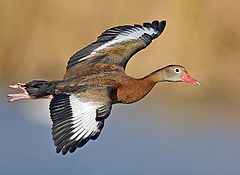Black-bellied whistling duck
| Black-bellied whistling duck | |
|---|---|
 |
|
| Northern subspecies (D. a. autumnalis, note brown breast). The white wing patch, a tell-tale feature of this species, is conspicuous in flight. | |
| Scientific classification | |
| Kingdom: | Animalia |
| Phylum: | Chordata |
| Class: | Aves |
| Subclass: | Neornithes |
| Infraclass: | Neognathae |
| Superorder: | Galloanserae |
| Order: | Anseriformes |
| Family: | Anatidae |
| Subfamily: | Dendrocygninae |
| Genus: | Dendrocygna |
| Species: | D. autumnalis |
| Binomial name | |
|
Dendrocygna autumnalis (Linnaeus, 1758) |
|
| Subspecies | |
|
D. a. autumnalis (Linnaeus, 1758) |
|
 |
|
| Range of D. autumnalis Non-resident Breeding range Resident range | |
D. a. autumnalis (Linnaeus, 1758)
D. a. discolor P.L.Sclater & Salvin, 1873
The black-bellied whistling duck (Dendrocygna autumnalis), formerly also called black-bellied tree duck, is a whistling duck that breeds from the southernmost United States and tropical Central to south-central South America. In the USA, it can be found year-round in parts of southeast Texas, and seasonally in southeast Arizona, and Louisiana's Gulf Coast. It is a rare breeder in such disparate locations as Arkansas, Georgia, Tennessee, and South Carolina, though it is now a common breeder in parts of central Florida. There is a large population of several hundred that winter each year in Audubon Park in uptown New Orleans, Louisiana. Since it is one of only two whistling-duck species native to North America, it is occasionally just known as the "whistling duck" in the southern USA.
The black-bellied whistling duck is a mid-sized waterfowl species. Length ranges from 47 to 56 cm (19 to 22 in), body mass from 652 to 1,020 g (1.437 to 2.249 lb) and wingspan ranges from 76 to 94 cm (30 to 37 in). It has a long red bill, long head and longish legs, pale grey head and mostly grey-brown plumage. The belly and tail are black, and the body plumage, back of the neck and cap are a rich chestnut brown. The face and upper neck are grey, and they sport a thin but distinct white eye-ring. The extensive white in the wings is obvious in flight, less so on the ground; it is formed by the secondary remiges while the primaries are black; the wing-coverts are brown. Males and females look alike; juveniles are similar but have a grey bill and less contrasting belly.
...
Wikipedia

